Labour Force
- Home
- Statistics
- Labour Market
- Labour Market Information
- Labour Force
Principal Statistics of Labour Force, Malaysia, Third Quarter (Q3) 2020
Key Statistics of Labour Force in Malaysia, August 2020 11 September 2020
Key Statistics of Labour Force in Malaysia, July 2020 7 August 2020
Key Statistics of Labour Force in Malaysia, June 2020 7 August 2020
Principal Statistics of Labour Force, Malaysia, Second Quarter (Q2) 2020 14 July 2020
Key Statistics of Labour Force in Malaysia, May 2020 15 June 2020
Key Statistics of Labour Force in Malaysia, April 2020 Show all release archives
Overview
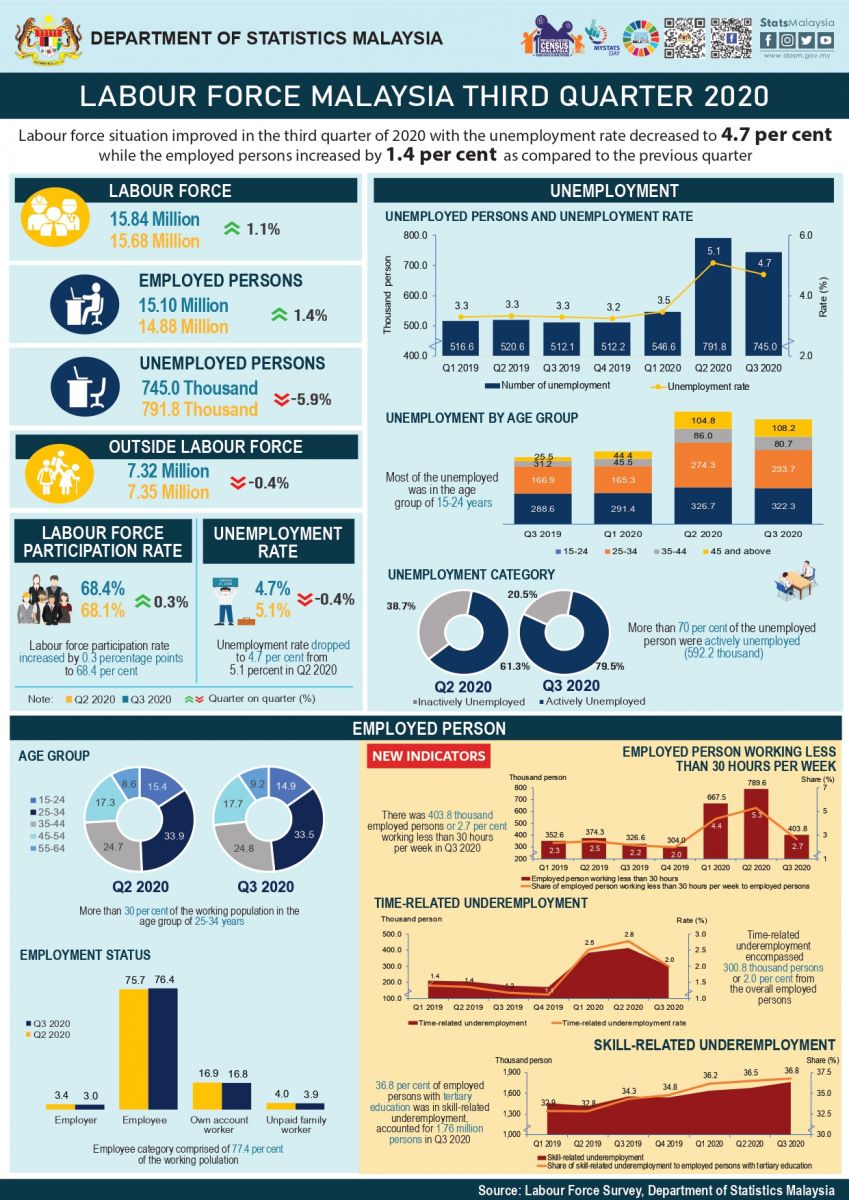
LABOUR FORCE IN MALAYSIA
Labour force increased 1.1 per cent t o 15.84 million persons while employed persons decreased by 0.4 per cent to 15.10 million persons as compared to the third quarter of 2019. Quarter-on-quarter, labour force and employed persons inclined 1.1 per cent and 1.4 per cent respectively as against previous quarter. Labour force participation rate (LFPR) in the third quarter of 2020 rose 0.3 percentage points to 68.4 per cent from 68.1 per cent in second quarter of 2020. The employment-to-population ratio increased by 0.6 per cent to 65.2 per cent as compared to second quarter 2020. Meanwhile during this quarter outside as labour force stood at 31.6 per cent.
The unemployment rate dropped 0.4 percentage points quarter-on-quarter to 4.7 per cent as the number of unemployed persons reduced by 46.8 thousand to record 745.0 thousand persons. [Exhibit 2]
Exhibit 2: Principal Statistics of Labour Force, Malaysia, Third Quarter (Q3) 2019, Second Quarter (Q2) 2020 & Third Quarter (Q3) 2020
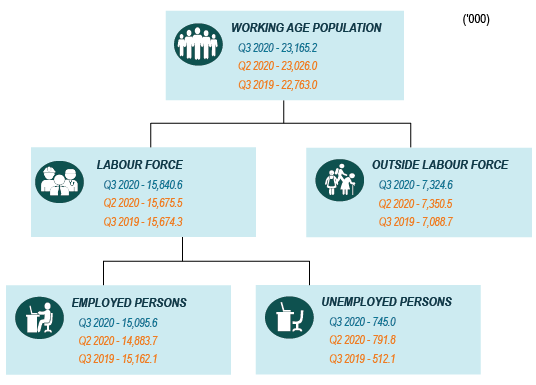
Female LFPR in the third quarter 2020 was 55.3 per cent, rose by 0.3 percentage points from the previous quarter. The highest female LFPR in the labour market was for the age group of 25 to 34 years (72.8%), followed by 35 to 44 years (67.4%) and 45 to 54 years (61.1%). Male LFPR increased by 0.3 percentage points to 80.5 per cent from 80.2 per cent in second quarter of 2020. The age group that recorded the highest male LFPR was 35 to 44 years (97.3%) followed by 45 to 54 years (95.2%) and 25 to 34 years (94.9%). [Exhibit 3]
Exhibit 3: Labour Force Participation Rate by Sex and Age Group, Malaysia, Second Quarter (Q2) 2020 & Third Quarter (Q3) 2020
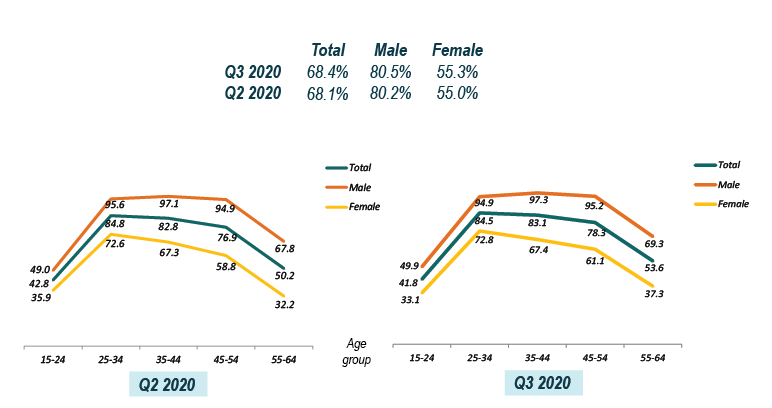
In this quarter, the employment to population ratio for male increased 0.3 percentage points to 76.7 per cent while for female rose 0.8 percentage points to 52.7 per cent as compared to the second quarter of 2020. [Exhibit 4]
Exhibit 4: Main Indicator by Sex, Malaysia, Third Quarter (Q3) 2019, Second Quarter (Q2) 2020 & Third Quarter (Q3) 2020
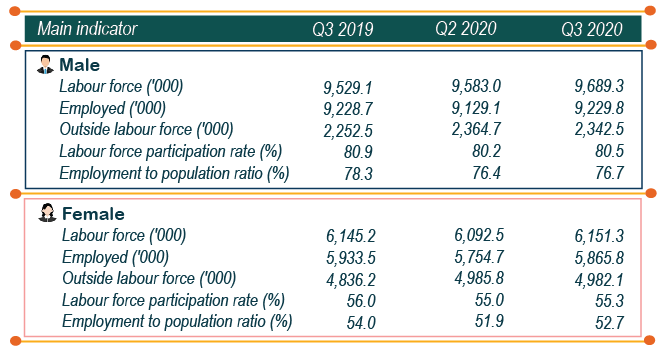
In the third quarter of 2020, the labour force comprised of male (61.2 per cent or 9.69 million persons) and 38.8 per cent or 6.15 million persons for female. The number of labour force for male and female increased by 106.3 thousand persons and 58.8 thousand persons respectively as compared to the second quarter of 2020. [Exhibit 5]
Exhibit 5: Labour Force by Sex, Malaysia, Second Quarter (Q2) 2020 & Third Quarter (Q3) 2020

PROFIL EMPLOYED PERSON
Employed person with secondary education attainment dropped 0.5 percentage points to 8.37 million persons while the number of employed persons with tertiary education rose 0.9 percentage points to 4.79 million persons (Q2 2020: 4.59 million persons). [Exhibit 6]
Exhibit 6: Employed Person by Educational Attainment, Malaysia, Third Quarter (Q3) 2019, Second Quarter (Q2) 2020 & Third Quarter (Q3) 2020
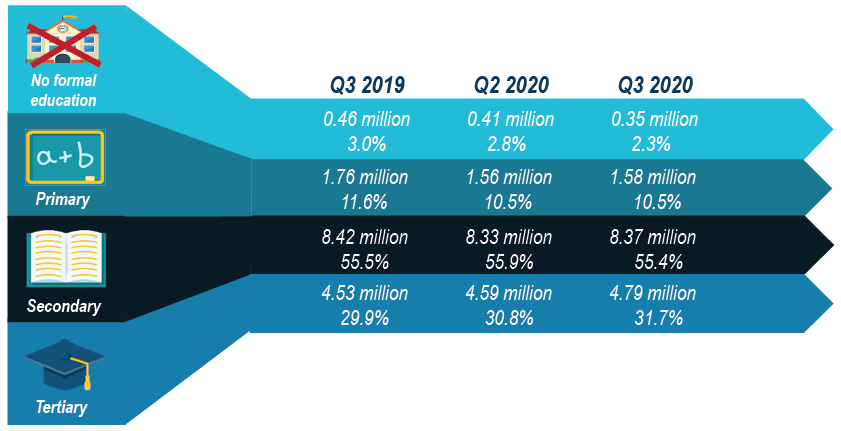
In the third quarter of 2020, employees category contributed 11.53 million persons or 76.4 per cent of total employed person. Meanwhile, the percentage share of own-account worker decreased 0.1 percentage point. However, the number of own account worker increased from 2.52 million persons to 2.53 million persons as compared to previous quarter. [Exhibit 7]
Exhibit 7: Employed Persons by Employment Status, Malaysia, Second Quarter (Q2) 2020 & Third Quarter (Q3) 2020

The semi-skilled workers dominated the labour market by 58.5 per cent followed by skilled workers (29.1%) and low-skilled workers (12.4%) in the third quarter of 2020. The number of skilled workers increased by 132.0 thousand persons to 4.39 million persons as compared to 4.26 million persons in the second quarter of 2020. Meanwhile, the composition of low-skilled workers also increased from 12.3 per cent in second quarter of 2020 to 12.4 per cent in third quarter of 2020. [Exhibit 8]
Exhibit 8: Employed Persons by Skill Level,Malaysia, Second Quarter (Q2) 2020 & Third Quarter (Q3) 2020
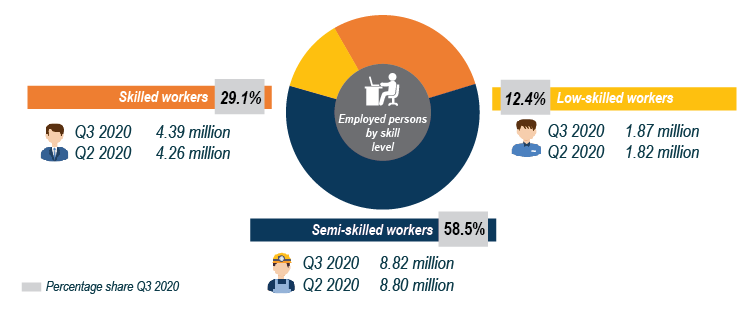
NEW INDICATOR RELEASED
A comprehensive understanding of the labour market requires analysing additional indicators alongside the unemployment rate . Thus, to provide more insight on the Malaysia’s labour supply situation in line with the current circumstances, new indicators are introduced for the first time in this report namely working less than 30 hours per week, time-related underemployment and skill-related underemployment.
Employed person working less than 30 hours per week refers to those who worked less than 30 hours during the reference week because of the nature of their work or due to insufficient work. For the third quarter of 2020, the number of employed persons who working less than 30 hours per week reduced 385.8 thousand persons to record 403.8 thousand persons (Q2 2020: 789.6 thousand persons).
In line with this, the share of those working less than 30 hours per week to the total employed persons decreased significantly to 2.7 per cent in this quarter (Q2 2020: 5.3%). The decline was due to the implementation of Recovery MCO starting June 2020 as resumption of more economic activities during the quarter.
As observed for the series of Q1 2019 to Q3 2020, the share of those working less than 30 hours per week to the total employed persons within the range of 2.0 per cent to 2.5 per cent during the year of 2019. However, the share increased at a faster rate began in the first quarter of 2020 at 4.4 per cent and continued to increase at a high rate of 5.3 per cent in the second quarter of 2020 due to the adversely impact of the MCO in mid of March 2020.[Exhibit 9]
Exhibit 9: Employed person working less than 30 hours per week, First Quarter (Q1) 2019 – Third Quarter (Q3) 2020
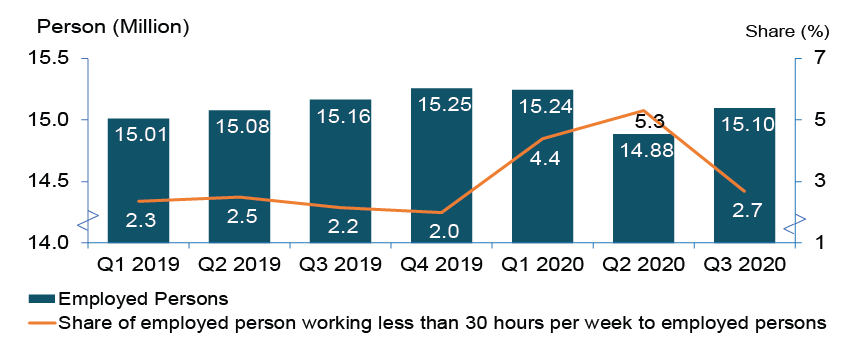
For a series of Q1 2019 to Q4 2019, the time-related underemployment averaged of 1.4 per cent from the total of employed persons equivalent to 212.4 thousand persons. The implementation of MCO in the mid of March 2020 has caused the number increased further to 383.2 thousand persons (2.5%) in Q1 2020. Subsequently, the continuous phases of MCO and several economic activities were allowed to operate with strict standard operating procedure in Q2 2020, led to the increase in time-related underemployment to 413.5 thousand persons (2.8%). Nevertheless, the number reduced to 300.8 thousand persons (2.0%) in Q3 2020 following the implementation of Recovery MCO with longer business operation hour during the period. [Exhibit 10]
Exhibit 10: Time-related underemployment, First Quarter (Q1) 2019 – Third Quarter (Q3) 2020
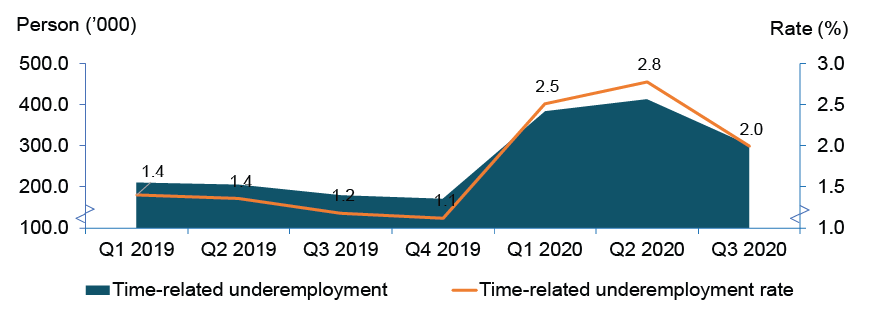
Through the LFS, skill-related underemployment is measured from the perspective of those with tertiary education and working in the semi-skilled and low-skilled occupations. Over the years, it was observed that the incidence of skill-related underemployment, had indicates the existence of some structural issue in the labour market prior to COVID-19 pandemic. This is portrayed by the quarterly average of 32.7 per cent or 1.4 million persons of skill-related underemployment during the period of Q1 2019 to Q4 2019. Incidentally, the current situation attributed to the continuous increase of skill-related underemployment to 36.8 per cent in the Q3 2020 after registering 36.5 per cent in Q2 2020. In terms of number, it increased to 1.76 million persons (Q2 2020:1.67 million persons). [Exhibit 11]
Exhibit 11: Skill-related underemployment, First Quarter (Q1) 2019 – Third Quarter (Q3) 2020
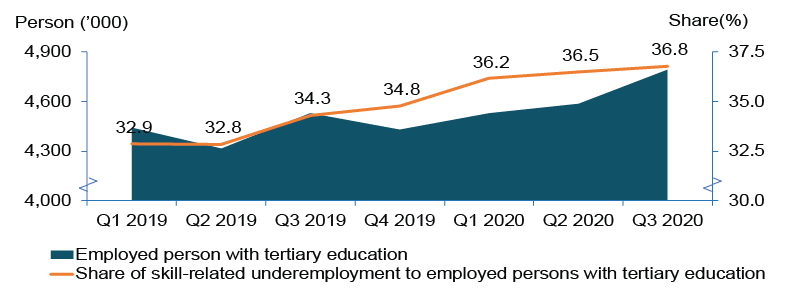
PROFILE OF POPULATION OUTSIDE LABOUR FORCE
The population of outside labour force accounting for 7.32 million persons in the third quarter of 2020. The main reasons of not seeking for work among the population outside labour force was housework/family responsibilities (43.5%) and schooling (40.1%). Both groups have the potential to join the labour market if they are interested in working. [Exhibit 12]
Exhibit 12: Population Outside Labour Force by Reasons for Not Seeking Work, Malaysia, Second Quarter (Q2) 2020 &Third Quarter (Q3) 2020
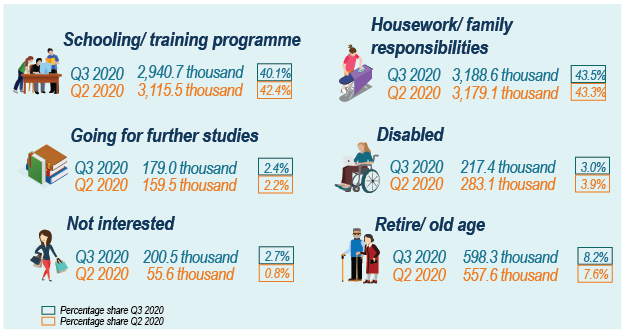
The detailed information and technical notes are published in the Labour Force Survey Report, Malaysia, Second Quarter 2019. This report is accessible and downloadable free of charge through the eStatistik application in DOSM web page, www.dosm.gov.my.
Released By:
DATO' SRI DR. MOHD UZIR MAHIDIN
CHIEF STATISTICIAN MALAYSIA
DEPARTMENT OF STATISTICS, MALAYSIA
9 November 2020
Contact person:
Mohd Yusrizal bin Ab. Razak
Public Relation Officer
Strategic Communication and International Division
Department of Statistics, Malaysia
Tel : +603-8885 7942
Fax : +603-8888 9248
Email : yusrizal.razak[at]dosm.gov.my
Subscribe
Newsletter
Subscribe to our newsletter and stay updated
For interviews, press statement and clarification to the media, contact:
Baharudin Mohamad
Public Relation Officer
Email: baharudin[at]dosm.gov.my
Phone: 03 8885 7942
Not found what you looking for? Request data from us, through
Go to eStatistik
email to data[at]dosm.gov.my
call 03 8885 7128 (data request)









